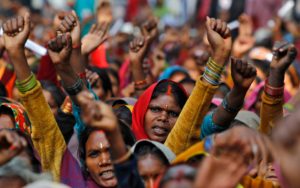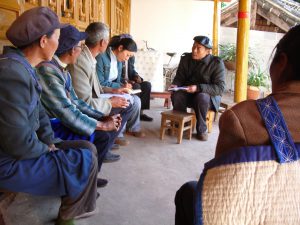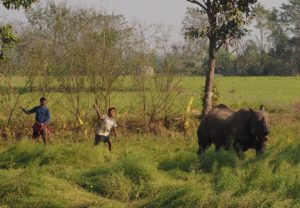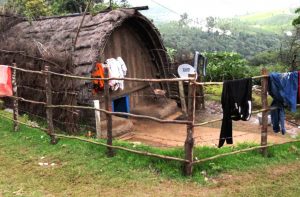In the aftermath of COP26 negotiations in Glasgow, the question has been raised as to why India did not sign the ‘Glasgow Leaders’ Declaration on Forests and Land Use’. Signed by 138 countries – including India’s neighbours Bangladesh, Bhutan, China, Nepal and Pakistan – the declaration committed to “halt and reverse forest loss and land degradation by 2030”.
Perhaps we are asking the wrong question. When you look beyond the headlines, such declarations often amount to an excuse for continued greenwashing through forest carbon offsetting by big polluters and governments, delaying urgent reductions in carbon emissions. The real question is this: is India willing to take meaningful action on climate change to address the systemic inequalities faced by rights holders and communities?
Ignoring indigenous communities in forests
Despite hopes that COP26 in Glasgow would be the most pivotal United Nations climate conference since Paris, many felt it turned a blind eye to the voices and demands of those on the front lines who are most impacted by climate change, such as forest-dependent communities and indigenous and rural women and girls. Instead, the summit favoured corporate lobbies and governments pushing for false solutions under the umbrella of so-called ‘nature-based solutions’, which were high on the agenda.
A clear example of these false solutions is one of India’s flagship climate projects, the Green India Mission (GIM), financed significantly by the Compensatory Afforestation Management and Planning Authority (CAMPA). This programme allows corporations involved in mining and other industries to pay a certain amount for the deforestation caused by their project to finance compensatory afforestation. This compensatory afforestation is supposed to offset the carbon emissions caused by the deforestation.
Monoculture promoted as ‘afforestation’
In practice, this mostly involves the expansion of monoculture tree plantations. Unlike the natural forests that have been destroyed by mining and other activities, monoculture tree plantations are often made up of species that are not indigenous to the area, with negative impacts on biodiversity and the water table, and without the contributions to sustainable livelihoods offered by natural forests.
Afforestation and carbon offset programmes like this, according to a recent report from the Global Forest Coalition, are essentially undermining progress towards effective forest conservation, community-led forest governance and gender justice in India. In the report, indigenous Dhanwar women from a Chhattisgarh village named Bakhai describe how their communities confronted India’s Forest Department officials and stopped the felling of trees that had been taking place in their forests to make way for a GIM-linked commercial plantation. The Forest Department responded by trying to plant trees on rights holders’ land without the consent of the villagers. This is a common Forest Department practice nationwide as part of its afforestation and compensatory afforestation projects on behalf of GIM and CAMPA: land needed for such projects is often obtained from common lands in villages, or even agricultural lands.
Passed off as “climate mitigation strategies”, actions such as these do not respond to the needs and wellbeing of the groups most affected by climate change, particularly indigenous women, even though they are the least responsible for the crisis and, in fact, have solutions to offer.
Indigenous solutions offer good options
India’s Scheduled Tribe and Other Traditional Forest Dwellers (Recognition of Forest Rights) Act of 2006, also known as the Forest Rights Act, recognises and restores the rights of forest communities, including individual rights over homesteads and agricultural lands and the collective rights to resources within and around village boundaries. The provisions of this landmark legislation – especially the provision which made permission by village councils (gram sabhas) mandatory – enabled indigenous Dhanwar women to resist deforestation and monoculture plantations.
The indigenous Dhanwar women have managed to transform their village through forest conservation and innovative agro-ecological food systems. Women in forest communities often hold profound knowledge of forest resources and conservation practices. The Forests Rights Act provides women with a platform, through representation on the village council, to share their perspective and understanding of conservation practices and resource governance. This is exactly what happened in Bakhai.
The women of Bakhai led an initiative to map the community resources in their forests and formed a community forest management committee (CFMC). The villagers established seed banks of forest species, and the women created nurseries for fruit-bearing trees. In 2018, Bakhai women started cultivating annual crops using no-till and organic techniques, which increases nutritional content and locks carbon in soils. Root crops, seeds and pulses are now grown in small patches as a part of three-tier cultivation practices. The women revived agro-ecological farming practices with millet. Their innovations include drip-irrigation systems based on earthen pots with a small hole at the bottom to water new plants in the summer. This technique is well suited to Bakhai’s hilly land, which does not retain water easily, and it improves the community’s resilience to changing rainfall patterns as a result of climate change.
To preserve their traditional practices and knowledge, the women of Bakhai created a resource centre that showcases traditional rice varieties and tree seeds, allowing them to share their traditional knowledge of forests and biodiversity with children in the village.
Indigenous rights help forests
However, they have still been unable to secure community rights over their forest resources. The government has yet to officially record their rights, in violation of the Forest Rights Act, wasting a great opportunity to strengthen forest conservation, climate action and the livelihoods of forest-dwelling communities in the area.
Instead, the government’s priority seems to be to support strategies devised to avoid taking urgent action. Instead, we see vague ‘net zero’ pledges from polluting industries and carbon offsetting and reforestation schemes which rely on monoculture tree plantations, such as CAMPA and GIM. These policy agendas are being disguised as truly transformative climate action. Instead, what we need are solutions by – and for – rights holders and communities.

![map of active fires in Brazil as observed by Terra and Aqua MODIS between August 15-22, 2019 [image courtesy: NASA]](https://www.thethirdpole.net/content/uploads/2019/08/NASA-amazon-1-300x251.jpg)


